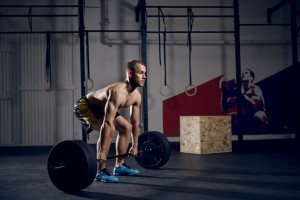Posted on October 14, 2015 by Jenny Cromack
The deadlift is a fundamental exercise which we include in the majority of individuals programs to some extent. For the development of posture and strength, particularly of the posterior chain it is untouchable. There are several tweaks, variations and manipulations we can make to focus the deadlift to meet our specific goals. During this blog I’m going to run through the main variations I use with my personal training clients and the rationale behind these variations, hopefully you’ll be able to start to use some of them to meet the specific demands of your training.
Deadlift Variation 1: Romanian Deadlift
Similar to the conventional deadlift, however in this variation the legs remain almost straight (a slight bend at the knee should be maintained) as the bar is lowered focus is placed upon the hamstrings, and to an extent the glutes. If you don’t feel a stretch in the hamstrings you’re not doing the exercise correctly and need to see a personal trainer for corrections. As with all deadlift variations you need to maintain a neutral spine.
Deadlift Variation 2: Sumo Deadlift
The sumo deadlift is common in powerlifting and strength circles, by increasing the width of the stance we shorten the distance the hips have to travel to move the weight. Basically this means we can lift a greater load, in terms of strength development its not a favourite of mine, as I believe it sacrifices the greater development of musculature of the hips seen in conventional deadlifts. What’s more the sumo deadlift variation requires the individual to utilise a narrow alternating grip, which can be tricky and exposes the bicep of the supinated palm to tears. Something to bear in mind with greater loads.
Deadlift Variation 3: Single Leg Dumbbell Romanian Deadlift
This variation is a great tool for sport specific clients, single leg movements are common in sporting actions. Therefore specificity would suggest that training musculature some of the time in this way would be beneficial. The single leg RDL provides excellent eccentric strength training to each hamstring, as well as helping to enhance proprioception, force application and counter rotational capacity. To complete this exercise simply raise one leg from the floor and allow it travel backwards when the break at the hip is initiated.
Deadlift Variation 4: Partial Pull (height can vary)
The partial pull is a very specific variation that can be utilised for numerous goals. Strength in the deadlift is greatest closer to the top of the movement and weakest at the bottom of the movement, its stands to reason then that the weight lifted is limited by what you can pull at the lowest portion of the movement. We can still develop strength at different angles, therefore we can set the bar at different heights and load the bar with greater loads as we move up the angles. Another great use for the partial pull is developing strength at specific joint angles associated with specific sporting actions, such as the angle of lunge during fencing, or kicking during Taekwondo.
Deadlift Variation 5: Deficit Deadlift
Progressing from the partial pull, we can actually create a deficit deadlift, this is in essence making the lift considerably harder from the ground. To complete this lift you will need bring the barbell closer to the ground, the easiest way of achieving this is to stand on a small 1-4 inch podium (this lift is often referred to as a podium deadlift for this reason). This will require you to increase joint angles dramatically to get the body low enough to lift the weight. For improving absolute or relative strength this is an amazing exercise that has helped many bust through plateaus, however you need to be able to maintain good posture in a very demanding position, so flexibility may need to be a focus.
If you have any questions about any of the variations or want to give them a try drop me a line, I’d be more than happy to help.


